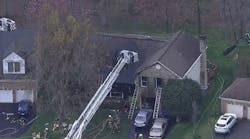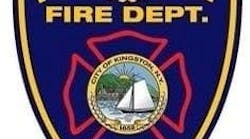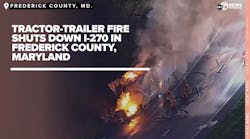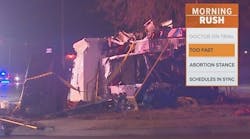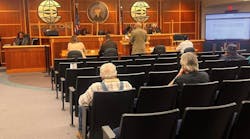"Unbelievable" was the word most often used to describe the gruesome crash site of the Metro Rail accident in Washington, DC, on Monday, June 22, 2009.
The daily commuter homebound rush was well underway when the first call for help went out at 5 P.M. The initial dispatch call for help was as unbelievable as the crash itself. A "Metro Box" alarm was sounded for the Fort Totten Metro Station on the "Red Line" as the primary location, with additional fire and EMS units being dispatched to the Takoma Metro Station as the secondary location.
The unusual part of the dispatch was that a major collision had occurred and one train car was reportedly resting atop another. The Takoma Metro Station is three blocks from my home, so I knew the area and the track bed reasonably well, and I was one of the "Doubting Thomases" who didn't believe that the dispatch information would turn out to be reliable. We were a little taken aback by the brief initial report of the first-arriving engine company: "Engine 26 is on the scene of a Metro train derailment with one car resting on top of another."
The company officer that day was Sergeant William Kennedy. He went on to declare a major incident and asked for a mass-casualty response. Kennedy would set the stage for one of the region's largest mass-casualty incident (MCI) responses in recent memory. This article is a firsthand account of the actions of the brave men and women of the District of Columbia Fire and EMS Department and the National Capital Region.
The Rail System
The rapid-transit rail system known as "The Metro" opened in Washington on March 27, 1976. It is a modern, clean and safe system that has been expanded over the years to incorporate Northern Virginia and adjacent nearby Maryland. The system moves more than 215 million passengers per year, featuring surface, elevated and below-grade (tunnels) rail tracks. The Washington Area Metro Transit Authority (WAMTA) is governed by a board of directors that are representative of the National Capital Region. The system is just about the best way to get around our city and is convenient and cost effective. This crash was the worst in the system's 33-year history.
The subway system has 106.3 miles of track and operates 86 stations. The 906 rail cars operated by WAMTA range from 1976 to 2008 models, as each generation of cars provides new and upgraded features. The collision involved two six-car trains, with each train consisting of three "married pairs" of two cars each. The rail cars are 75 feet in length, 10 feet in width and have a capacity of 175 to 187 passengers per car, depending on the car model. Each car rests on top of two sets of wheel assemblies called "trucks." The trucks are machined, case-hardened steel structures containing the electric motors that propel the train. A "boot," or "shoe," rests on top of the third rail, powering the electric motors and other accessories associated with the operation of the passenger cars (lighting, air conditioning and door operations as examples). The system is electrically operated using a "running" third-rail process which delivers 750 volts of direct current as the prime motivation for the train. This electrical energy level is fatal, so precautions are in place to keep people away from the third rail.
The Accident
Just before the deadly event, a train was stopped at the Fort Totten passenger platform for more time than planned. This delay caused Train Number 214 to be stopped on the inbound (south) track to await clearance. As Number 214 waited, Train Number 112 was operating at speed (reported to be 59 mph) and was behind the stopped train. As Train 112 rounded the bend underneath the New Hampshire Avenue overpass, the last car of 214 was now in sight. As initially reported by National Transportation Safety Board (NTSB) Investigator-In-Charge Debbie Hersman, it is believed that the operator depressed the "mushroom" (emergency brake) and the braking system was engaged for about some 400 feet. However, at the operating speed of nearly 60 mph the stopping distance was way too short to stop the oncoming train prior to impact. Train 112 struck the rear of the standing Train 214 and, as a passenger best put it, "all hell broke loose."
Upon impact, the striking train's exterior shell did a "telescope" over the top of the standing train car, giving the effect of one train car coming to rest on top of another. It was amazing to witness, but the sad reality was only the exterior shell was atop on the standing train. The trucks, framing and the passenger compartment all took the brunt of the impact. As noted earlier, a standard Metro rail car is 75 feet long. The leading car of Train Number 112 was now compressed to about 25 feet. That means about two-thirds of the car had been crushed, much like someone would squeeze an accordion. An amazing sight to see up close, but the "survival" space in the lead car was tremendously reduced. As best we can determine, all nine fatalities were riding in this space.
The collision occurred underneath the New Hampshire Avenue overpass, which is just about in the middle between the two station platforms. It was at 5 P.M. on a warm and clear day. The stretch of tracks was at grade level (not in a tunnel or elevated). The location, time of day and weather were all to the responders' advantage. The train was southbound (traveling toward downtown DC) with a smaller load of passengers. Outbound trains at this time of day are generally packed to capacity. The tunnel would have made the dozens upon dozens of rescues much more difficult. And, if people were on an elevated section of track, self evacuation would not have been possible, overwhelming the 200-plus members that responded that night.
The timing proved to be another advantage, in that all of the senior and executive officers assigned to DC Fire and EMS Headquarters were at their desks and just a few miles from being on location. This fact helped to strengthen the command and overhead team. The official NTSB report is not due out for about another year, but the preliminary indication is that about 300 to 400 customers were riding on the two trains.
A Dangerous and Difficult Operation
The initial-arriving companies gave a clear and concise brief initial report. It was transmitted and understood that this was a major incident and many people were hurt by the impact. The first few operating units approached both trains from both sides (A and C) to control and guide the flow of passengers. High on the operational priority list is shut off, locking out and tagging the 750 volts of direct current. However, the initial companies had to forgo that most basic safety consideration if they were to guide and direct the several hundred walking wounded and unharmed people to safety. The companies fully understood the extra danger they were in and that the passengers had to be guided from harm immediately or this horrible situation would become much worse.
Command and operations section were quickly established at this incident. Assistant Fire Chief Lawrence Schultz (Operations chief) would be the incident commander and Deputy Fire Chief Tim Gerhart (Operations Deputy) was assigned the task of Operations Section chief. Several mission-critical objectives had to be handled simultaneously. Along with the triage, treatment and transportation of the scores of injured was the instant need to shut off the electricity to the third rail and lock out and tag out the deadly incoming energy.
Maryland Area Regional Commuter (MARC) passenger trains and CSX freight trains use the same tracks, so it was critical to control and stop that traffic near this site. The lives of hundreds of fire and police first responders would rely on this action to be taken quickly and effectively. Additional resources would be needed, so early calls for three mass-casualty task forces (each with an ambulance bus, supply support unit, five ambulances and a supervisor), a third-alarm response (18 engine companies, seven ladder companies, four heavy rescues, and dozens of staff and specialty units) were called.
All of the injured people who could be accessed without extended extrication action were triaged and move to the treatment area under the command of Evacuation Branch Director Battalion Fire Chief Kevin Sloan. A tall fence section (approximately 15 feet high) needed to be cut opened top to bottom to allow responder access and to move patients to staged ambulances. Coordination with patient hospital distribution was handled by our Emergency Medical Liaison Officer assigned to the Office of Unified Communications (DC's Police and Fire Dispatch Center — a joint facility).
During this time, many people who were on the trains, but not injured, were provided with transportation to their homes by Metro Rail. This was a great customer service gesture, but added a degree of difficulty to the search-and-rescue process as it related to accounting for all passengers off of both trains. Once the removal, triage, treatment and transportation of the injured were well in hand, Special Operations began gearing up to conduct a difficult and challenging extrication operation. Deputy Fire Chief Craig Baker was assigned as the Rescue Branch director.
Within the first 10 minutes of declaring a major MCI, our Fire Operations Center — essentially, this is DC Fire and EMS' emergency operations center — was opened by Assistant Fire Chief Alfred Jeffery and Deputy Fire Chief Milton Douglas. To provide some background, the city is home to 600,000-plus residents and hosts about 1.5 million workers and guests each day. Knowing that we are sworn to protect all of the district's population, many more resources would need to be activated and moved into strategic positions. From the beginning of this single event until its conclusion, the department would be asked to respond to over 400 more emergency alarms for service. They would range from working building fires to automobile accidents to traumatic medical calls. Multiple tasks were handled through the "Fire Ops Center" to include activating dozens of reserve resources by calling back off-duty members; calling for and placing many mutual aid assets in our stations; ensuring that command was provided with all of the requested resources; and providing financial documentation for the entire operation to prepare for reimbursement.
As night approached, the focus was to provide lighting and other critical support services to keep the 200 firefighters and about as many police officers operating. Portable lighting equipment from the Metropolitan Police and DC National Guard was moved into place, tested and prepared several hours before dusk, providing enough daylight to work out any issues with bringing this equipment on line before night fall (it is a lot easier to add fuel in the daylight, for instance). The Friendship Fire Association was called upon to provide food and drink. Led by Director Walter Gold and Assistant Director Vito Maggiolo, the unit's performance was outstanding. If food and drink would be required to continue to operations, plans to have portable toilets were next on the list. Six portable toilets were delivered before dark and used through this event.
Next, responders had to find, extricate and remove what would turn out to be nine fatalities. Several individuals who were killed were relatively easy to extricate and disentangle from the wreckage. Most of those who died were trapped in the remaining 25-foot section of the lead car that struck the standing train. When the car was compressed to about a third of its original size, its occupants were entombed in steel. This task was difficult and gruesome.
At about 4:30 the following morning, a CSX track-mounted 100-ton crane arrived. It had been called in the early phase of this operation; however; it takes a while to locate and move into position a crane of this size that can operate on train tracks. Upon arrival of this device, the large once-immovable chunks of steel were lifts and placed in a "spoil pile" of scrap.
The overhead crane, using nylon sling straps to grasp the remnants and remove then, would get the large twisted components out of the way. When the operation approached a human body part, the overhead crane was removed and replaced by hand crews with various hydraulic tools. The hand-operated tools included spreaders, cutters, jaws and saws of different types. Using the crane and slings for the large and heavy material followed by the completion of the extrication process with hand tools worked effectively.
Generally, the standard complement of hand tools carried on a heavy rescue unit is not capable of lifting or cutting through train components. The standard complement is designed to resolve automotive extrication situations and just won't touch the work that is required on a train. Either have a plan that incorporates the use of a railway crane device or consider calling in an urban search and rescue (USAR) team that has tools that can accomplish train extrications. The drawback to either selection is time. This time, the railroad was able to produce an effective crane in a reasonable time, but this may not always be possible, so keep the USAR resource in mind when faced with such a large-scale incident.
Lessons Learned Or Reinforced
- The Incident Command System (ICS) worked better than advertised. This alarm required a tremendous amount of response resources, logistical support and interagency coordination. By implementing ICS from the arrival of the first company, command and control was never in question. A unified command structure was developed within the first few minutes and used throughout the event. Fire and EMS was the lead agency for the duration of the rescue and recovery operation and the formal transfer was made to the Metro Rail Police Department at 1 P.M. on Tuesday, June 23, to continue the investigation process. Metro Rail Police was the agency that terminated the event later that day. By implementing the system, many support components were exercised, such as finance/administration and Logistic Services Branch that are not often used.
The emergency medical care that was provided to scores of people was outstanding. All eyes were focused on the "golden hour" of trauma care and every red- or yellow-tagged patient was delivered to the hospital within a 60-minute window. Most Fire and EMS senior operational medical officers were in attendance to oversee the provision of evidenced-based medicine to all of those in need of care. Deputy Chief Greg Blalock was the Medical Branch director and worked closely with the Operations Section chief and the Evacuation Branch director to provide the best care as soon as a person was identified with the need and placed in as safe of a position as possible.
Given all of the factors at this event, such as the large number of patients, severity of injuries and the degree of difficulty to perform extrication, the medical care on the "Red Line" that day will be studied in detail for its effectiveness and efficiency.
- Our patient triage system was implemented upon arrival of the first unit and was continued until all of the injured were cared for and transported to definitive care facilities. Battalion Chief Henry Lyles coordinated the triage and transportation process. Coordination with our EMS Liaison Officer and the mass-casualty management hospital (Children's Hospital) was critical in determining the best and most suitable hospital to receive a specific patient. The ambulance drop times at the emergency departments would be a critical factor in providing a continuous stream of available ambulances for both this incident and citywide needs.
- It could be said that in many ways this was a "lucky" event. First, the location of the event was on grade-level track; if this had been an elevated track or tunnel, the degree of danger and difficulty would have gone up significantly. It was luck that the train was heading into the city in that the outbound trains at that hour have a capacity load of passengers. Next, the time of day was ideal to provide the maximum amount of senior and executive level of command officers to this event. The weather was mild for the time of year and it wasn't raining. All of these would be described as elements that worked in our favor that day to keep the fatalities and injuries to the lowest level possible. However, I am certain the "luck" of the day was when training, preparation, education, personal effort and professionalism came together at this major event to help scores of needy passengers.
- Providing all types of logistical support and resources (goods and services) was a critical factor. Success would rest on providing the required number of ambulances, rescue units, firefighter/EMTs, food and beverages, portable lighting units, the rail crane and portable toilets, to mention just a few items. The Fire Ops Center had the responsibility to handle all of the many requests. This was a well-supported and well-stocked event. At one point, a short roadbed was constructed under the direction of Lieutenant Sean Egan to allow for transport units to move patients from the crash scene to the hospital. This lessened the risk of injury of the hundreds of responders. A temporary morgue had to be established to process the precious human remains properly and respectfully. The needed materials and supplies had to be provided and supported until all nine fatalities were processed and removed by our chief medical examiner.
- Only one minor firefighter injury was reported. More than 250 firefighters and EMTs worked for about 30 hours under extremely difficult conditions and only one minor injury speaks volumes about the overall safety program and the risk management profile that was used during this event.
- Accountability was implemented early and carefully tracked until this alarm was terminated. Our department uses aides (the rank of fire sergeant). Sergeant Eddie Lehan had this responsibility and he ensured that we knew who was at this incident, where they were, what they were doing and the conditions that they were operating under. Further, apparatus and other response assets in the immediately dangerous to life and health (IDLH) zone — mostly police units — had to be accounted for. The personnel accountability tag system worked.
- The Fire Operations Center coordinated and provided a wide range of resources. The derailment required a third alarm and several special calls for help. This fact mandated the need to cover most of our firehouse with outside resources. While DC Fire and EMS was operating at this event, more than 400 other calls for assistance we received and answered. Making sure that all of the resource needs were met and keeping track of a very busy system was a major task for Fire Ops.
Managing media relations was a significant focus. Dozens of radio, TV and newspaper reporters from around the world were in attendance. At one count, there were more than 50 TV satellite trucks on location reporting on this story. The typical news reporter assumption in the greater DC area that all events are terrorist acts until proven otherwise. This crash is under investigation by the NTSB and terrorism has been ruled out.
Mayor Adrian M. Fenty and Police Chief Cathy Lanier attended each of the three structured and planned press conferences along with various other experts and dignitaries. The scheduled media conferences kept the media informed and updated with the rescue and recovery activities. About a dozen live broadcasts were supported by the mayor, police chief or fire chief to include a national appearance on CNN's "Larry King Live" program. Only a single complaint was expressed by a local reporter about a failure to provide timely information. Not that even one complaint is acceptable, but considering the number and the level of reports that were on location, that was exceptional.
The incident command staff (overhead team) had to forecast the situation status and resource needs well in advance of the actual need. For instance, quickly stopping all train traffic (CSX, MARC and Metro) at and near the affected area was a critical safety factor. Next, ensuring the third-rail power was locked out and tagged out had to occur to protect all first responder members and the train riders.
Some not-so-obvious considerations had to be addressed early to have a positive impact. Calling for the rail crane to de-scale and remove the huge chucks of steel hours later or providing direction for rescue work-rest cycles and relief of fatigued personnel would all be examples of forecasting the operation needs and staying ahead of the events so that it would end successfully. Being able to forecast and prepare for eventual needs is a skill of a highly experienced team that is battle tested and that has worked together many times.
- Critical incident stress management (CISM) was provided or offered to all responding members as part of the termination process of this event. Our peer debriefing team is led by Battalion Fire Chief Claude Ford and Lieutenant Kevin Stuart, supported by Father Peter Weiss. They were activated early for this high-profile, gruesome event. As they were starting the CISM process, we received a call from International Association of Fire Fighters (IAFF) Local 36 President Raymond Sneed, offering to support the departmental team's effort to assist all of our employees. No members have been referred to mental health professionals, but several have had follow-up peer sessions.
Finally, I need to complete this report by pointing out the Special Operations members of DC Fire and Emergency Medical Services Department. Without question, every member who attended this difficult event contributed greatly to the success of this agency. However, if there is a "first among equals," it would have been the Special Operations members at this alarm. All of their skills were taxed and they, along with every responder, answered the challenge.
DENNIS L. RUBIN, a Firehouse® contributing editor, is chief of the District of Columbia Fire and Emergency Medical Services Department. He is enrolled in the Fire and Emergency Management Administration program at the graduate school of Oklahoma State University. Rubin is a graduate of the National Fire Academy's Executive Fire Officers Program, is a Certified Emergency Manager (CEM) and has obtained the Chief Fire Officer Designation (CFOD) from by the International Association of Fire Chiefs. He has been an adjunct faculty member of the National Fire Academy since 1983. Rubin is the author of the book Rube's Rules for Survival.
